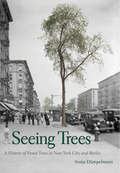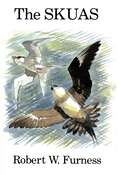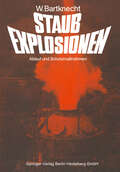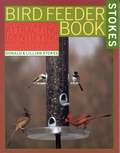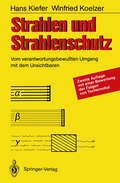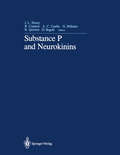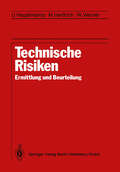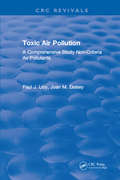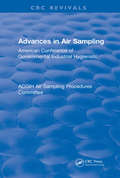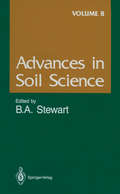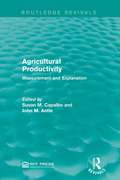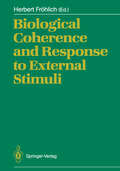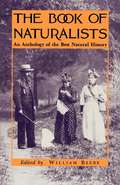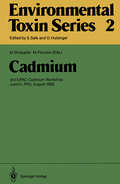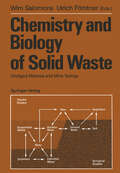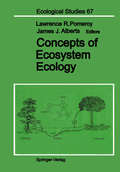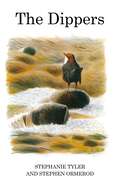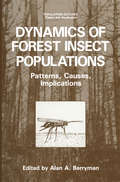- Table View
- List View
Seeing Trees: A History of Street Trees in New York City and Berlin (Seeing Ser.)
by Sonja DümpelmannA fascinating and beautifully illustrated volume that explains what street trees tell us about humanity’s changing relationship with nature and the city Today, cities around the globe are planting street trees to mitigate the effects of climate change. However, as landscape historian Sonja Dümpelmann explains, the planting of street trees in cities to serve specific functions is not a new phenomenon. In her eye-opening work, Dümpelmann shows how New York City and Berlin began systematically planting trees to improve the urban climate during the nineteenth century, presenting the history of the practice within its larger social, cultural, and political contexts. A unique integration of empirical research and theory, Dümpelmann’s richly illustrated work uncovers this important untold story. Street trees—variously regarded as sanitizers, nuisances, upholders of virtue, economic engines, and more—reflect the changing relationship between humans and nonhuman nature in urban environments. Offering valuable insights and frameworks, this authoritative volume will be an important resource for years to come.
The Skuas (Poyser Monographs #64)
by Robert W. FurnessMany birdwatchers may never have seen a skua; those who have will most probably have vivid memories of one or other species flying powerfully past a headland, or twisting and diving in pursuit of its piratical intentions towards a food-laden seabird - or, perhaps more memorably still, of themselves taking evasive action from the power-diving irate skua whose territory they have unwisely invaded. The full classification of the skuas is still debated, but Dr Furness of the Applied Ornithology Unit, Glasgow University, favours six species, of two genera, with five subspecies, based on current knowledge and his own long and dedicated field studies and research. All of the species are treated comparatively under the following chapter titles: Early history and classification, Distributions and populations, Migration patterns, Reversed sexual size dimorphism, Behaviour, Food and feeding, Kleptoparasitism, Plumage polymorphism, Breeding systems and social organisation, Breeding - laying to hatching, Breeding - hatching to fledging, Population dynamics, Pollutants, Skuas and agriculture, Skuas and conservation. The text is supported by 100 maps and diagrams, 30 photographs and 65 tables. In addition, John Busby contributes 35 evocative drawings which more than embellish this erudite and readable summary of an impressive and diverse group of birds. Jacket paintings by John Busby
The Stokes Birdfeeder Book: An Easy Guide to Attracting, Identifying and Understanding Your Feeder Birds
by Lillian Q. Stokes Donald StokesCopiously illustrated with maps, line drawings, and full-color photographs, this large format paperback book contains the essential information that backyard nature enthusiasts want and need to select feeders and understand the basics of birdfeeding.Now you can start to enjoy the birds at your feeder more than you ever have before! This book will help you in three important ways:You can attract more birds by following our easy method of providing the Four Basic Feeders. If you are just starting out, we offer helpful tips for choosing the best feeders and the birds' favorite foods.You can become an expert at identifying your feeder birds with this book. There is a beautiful color photograph of both male and female for each bird, accompanied by identification clues.You can understand the behavior of birds at your feeder, because for each bird there is a chapter filled with fascinating information about its life. Don't let another day go by without starting on this path to a richer experience at your feeders. Also included is your own Bird Feeder Journal.
Strahlen und Strahlenschutz: Vom verantwortungsbewußten Umgang mit dem Unsichtbaren
by Hans Kiefer Winfried KoelzerDas Buch erläutert die Entwicklung unserer Kenntnisse über Strahlen und setzt sich mit Fakten und Hypothesen zum Thema "Strahlen und Strahlenschutz" auseinander. Es ist bewußt so geschrieben, daß keine Kenntnisse in Physik oder Medizin zum Verständnis notwendig sind. Man findet die Entdeckungen der Röntgenstrahlen und der Radioaktivität genauso wie die Beschreibung der frühen Strahlenschäden. Ein Kapitel befaßt sich mit der Strahlenschutzmeßtechnik bis zu Entwicklungen aus allerjüngster Zeit. Die Strahlenexposition des Menschen aus natürlichen und künstlichen Quellen ist mit zahlreichen Tabellen und Abbildungen belegt. Ein weiterer Schwerpunkt ist die biologische Wirkung der Strahlung, wobei klar zwischen Hypothesen und Fakten getrennt wird. Aus diesen Erkenntnissen folgen schließlich die Risikoüberlegungen, die zu den heute gültigen internationalen Strahlenschutzempfehlungen führen.
Substance P and Neurokinins: Proceedings of “Substance P and Neurokinins—Montréal '86” A Satellite Symposium of the XXX International Congress of The International Union of Physiological Sciences
by Rejean Couture A. Claudia Cuello Georges Pelletier Remi Quirion Domenico RegoliSarajevo was the site of the first international meeting on substance P. It was held in 1961, thirty years after the first report of the discovery of substance P by Von Euler and Gaddum. The proceedings which follow are from a symposium held twenty-five years after the first meeting. These twenty-five years have seen a vast expansion in this field ofresearch. This family of peptides now includes a number of different mammalian and non-mammalian related peptides. Beyond the early physiological and pharmacological studies, there is important new information coming from the full spectrum of disciplines in the basic medical sciences, including molecular biology, which has given us important insights into the biosynthetic mechanisms of origin of these peptides. Montreal was chosen as the site for the 1986 meeting. The name given to it was "Sub stance P & Neurokinins-Montreal '86." This name was modelled after the one held in Dublin in 1982, but neurokinins were added to acknowledge the broader family of peptides. The meeting was held as a Satellite Symposium of the XXX International Congress of the International Union of Physiological Sciences in Vancouver. The venue was McGill University, and the dates were 21-23 July, 1986.
Technische Risiken: Ermittlung und Beurteilung
by Ulrich Hauptmanns M. Herttrich Wolfgang WernerDie Erweiterung der menschlichen Möglichkeiten durch die Nutzung technischer Hilfsmittel stand am Anfang menschlicher Zivilisation. Technik muß ein Hilfsmit tel zur Verbesserung der menschlichen Lebensbedingungen bleiben. Sie muß kalku lierbar und beherrschbar sein, damit nicht Kräfte entfesselt werden, die auch das Ende menschlicher Zivilisation bewirken können. Bereits die griechische Mytholo gie lehrt uns, daß Segen und Fluch eng beieinander liegen, wenn der Mensch über seine natürlichen Kräfte hinausstrebt. Prometheus straften die Götter, weil er den Menschen das Feuer brachte, ihr Leben erleichterte, ihnen jedoch damit zugleich göttergleiche Kräfte verlieh. Die uralte Botschaft ist aktueller denn je. Es gilt, die gewaltigen Möglichkeiten des technischen Fortschritts zum Wohle des Menschen zu nutzen, ohne zugleich zum Frevler an der göttlichen Schöpfungsordnung zu werden. Zum technischen Fortschritt gibt es keine Alternative. Nur mit Hilfe der Technik können wir den Wohlstand in den Industrieländern erhalten, die Lebensbedingun gen der Menschen in der Dritten Welt verbessern und auch die Umweltprobleme bewältigen. Wir wissen aber heute, daß mit der Erweiterung der technischen Möglichkeiten auch die Risiken anwachsen. Moderne Technologien wirken sich tiefgreifender und langfristiger denn je auf unsere menschliche Gesellschaft und auf die natürliche Umwelt aus. Viele befürchten eine nicht mehr kontrollierbare Eigendynamik. Unre flektiertes Wachstumsdenken und blinde Fortschrittsgläubigkeit sind deshalb nicht mehr verantwortbar. Technischer Fortschritt muß vielmehr immer wieder auf un angemessene Risiken und zweifelhaften Nutzen geprüft werden.
Toxic Air Pollution: A Comprehensive Study Non-Criteria Air Pollutants
by Paul J. LioyThe difficulties with addressing toxic air pollutants are the cheer number of compounds present in the atmosphere and their sources. The purpose of this book is to develop an approach to understanding toxic air pollutants through synthesis of the scientific results obtained in the Airbourne Toxic Element and Organic Substance (ATEOS) project.
Toxic Air Pollution: A Comprehensive Study Non-Criteria Air Pollutants
by Paul J. LioyThe difficulties with addressing toxic air pollutants are the cheer number of compounds present in the atmosphere and their sources. The purpose of this book is to develop an approach to understanding toxic air pollutants through synthesis of the scientific results obtained in the Airbourne Toxic Element and Organic Substance (ATEOS) project.
Advances In Air Sampling: American Conference of Governmental Industrial Hygienists (CRC Press Revivals)
by American Conference of Governmental Industrial HygienistsA copublication of the American Conference of Governmental Industrial Hygienists and Lewis Publishers, this series continues the former Annuals of the American Conference of Governmental Industrial Hygienists. This series is designed to present state-of-the-art information on research and practical applications of science in the field of occupational health. Bokos are normally the proceedings of an important symposium or conference sponsored by the ACGIH or other leading professional organization in, or allied with, the occupational health field. Content deals with subject of current interest. Books in the Industrial Hygiene Science Series should become valued additions to the international scientific literature. Published volumes in this series are: Microcomputer Applications in Occupational Health and Safety Ergonomic Interventions to Prevent Musculoskeletal Injuries in Industry Advances in Air Sampling.
Advances In Air Sampling: American Conference of Governmental Industrial Hygienists (CRC Press Revivals)
by American Conference of Governmental Industrial HygienistsA copublication of the American Conference of Governmental Industrial Hygienists and Lewis Publishers, this series continues the former Annuals of the American Conference of Governmental Industrial Hygienists. This series is designed to present state-of-the-art information on research and practical applications of science in the field of occupational health. Bokos are normally the proceedings of an important symposium or conference sponsored by the ACGIH or other leading professional organization in, or allied with, the occupational health field. Content deals with subject of current interest. Books in the Industrial Hygiene Science Series should become valued additions to the international scientific literature. Published volumes in this series are: Microcomputer Applications in Occupational Health and Safety Ergonomic Interventions to Prevent Musculoskeletal Injuries in Industry Advances in Air Sampling.
Advances in Soil Science (Advances in Soil Science #8)
by A. R. Bertrand J. C. Day R. J. Gibbs P. M. Huang R. E. Meyer A.S.P. Murthy R. I. Papendick J. B. Reid J. L. SteinerAdvances in Soil Science is a review series relevant to all areas of soil science. These reviews, intended primarily for scientists, teachers, and students of soil science, also provide technical background information for many additional workers and groups interested in our natural resources and man's influence on them. This is the eighth volume in the series with an international list of contributors from the United States, India, Canada and New Zealand. It contains four review chapters on the following subjects: factors affecting aluminum transformations in soil; soil productivity in dryland regions of developing countries; changes in soil structure under different cropping systems; properties and management of the depleted soils of India. These contributions present valuable information on a diversity of topics and serve as an excellent source of references.
Agricultural Productivity: Measurement and Explanation (Routledge Revivals)
by Susan M. Capalbo John M. AntleThis book, first published in 1988, provides a comprehensive, integrated body of knowledge concerning agricultural productivity research, highlighting both its strengths and limitations. This book will be of value to scholars and research leaders for the knowledge it conveys of future productivity research, and will also be of interest to students of environmental studies.
Agricultural Productivity: Measurement and Explanation (Routledge Revivals)
by Susan M. Capalbo John M. AntleThis book, first published in 1988, provides a comprehensive, integrated body of knowledge concerning agricultural productivity research, highlighting both its strengths and limitations. This book will be of value to scholars and research leaders for the knowledge it conveys of future productivity research, and will also be of interest to students of environmental studies.
The Book of Naturalists: An Anthology of the Best Natural History
by William BeebeAnyone curious about animals, nature, or the history of biology will find much of interest in this ample and varied collection. Reflecting his infectious enthusiasm for "the best natural history," Beebe's personal assortment of favorites includes excerpts from massive sources, such as Audubon and Darwin, and intriguing pieces from lesser known authors most of us would not normally encounter. Arranged in chronological order, the small masterpieces here range from Aristotle to Rachel Carson. Each of them is introduced by an incisive and sometimes humorous description of its author.
Cadmium: 3rd IUPAC Cadmium Workshop Juelich, FRG, August 1985 (Environmental Toxin Series #2)
by M. Piscator M. StoepplerOn May 25,1978, the Commission on Toxicology ofthe Division of Clinical Chemistry of the International Union of Pure and Applied Chemistry (IUPAC) established its Subcommittee on Environmental and Occupational Toxicology of Cadmium following aseries of Commission meetings in Kristiansand, Norway. I was appointed chairman ofthe new Subcommittee by the Commission on Toxicology (chairman at that time F. w. Sun derman Jr. ) in which I served from 1977 as an Associate Member and from 1979 as a Titular Member. From the beginning the Cadmium Subcommittee aimed not only at bringing together cadmium experts from around the world for scientific discussions but also at assessing, improving and the harmonization of analysis of cadmium. Due to the membership of many laboratories of the world engaged in scientific and analytical work on cadmium, and following some preliminary studies in a few laboratories from Sweden, The Netherlands and the Federal Republic of Germany, the Cadmium Subcommittee conducted from 1979 to 1985 four international interlaboratory surveys on cadmium analysis in body fluids. Two studies have been performed for cadmium in human and lyophilized bovine blood (1979 to 1980 and 1981) and another two for cadmium in artificial and human urines (1983 and 1985). At present in collaboration with the Selenium Subcommittee and the Subcommittee on Harmonization of Methods, a 5th survey for cadmium, lead and mercury in lyophilized human blood and serum reference materials is con ducted.
Cellular Ca2+ Regulation (Advances in Experimental Medicine and Biology #232)
by D. PfeifferThis book arose from a meeting held at the University of Washington, Seattle, in July of 1986. The meeting was a satellite symposium of the XXXth International Congress of Physiological Sciences which occurred in Vancouver, canada, at that time. 2 Adjustments in the cytoplasmic Ca + concentration of cells occur in response to a variety of external signals. These fluctuations are a cen tral component of one mechanism by which cells adapt their activities to changes in the external environment and to the requirements of whole body 2 homeostatic mechanisms. It is now clear that redistribution of Ca + within 2 intracellular compartments, as well as changes in the rates of Ca + influx and extrusion at the whole cell level, occur during signal-dependent 2 changes in the cytoplasmic Ca + concentration. In summarizing current research in this area, this volume considers first the properties of indi vidual cation transporting activities located in various cell membranes. It then moves to the cellular level, where the consequence of individual transporting activities acting in concert is examined. l!D.phasis is also 2 p1 aced on pa tho1 ogica1 conditions which resu1 t in loss of cell Ca + regu1 a tion as a part of the disease process. We hope that this approach will help the reader to integrate developments in this large and rapdi1y changing fie1 d.
Chemistry and Biology of Solid Waste: Dredged Material and Mine Tailings
by UlrichFörstner WimSalomonsDredged Material and Mine Tailings are two of the same thing once they are deposited on land: they must be safe-guarded, wash-out must be prevented, and they must be protected by a plantcover. This comprehensive treatise covers both important aspects of their management: In Chemistry and Biology of Solid Waste the principles and assessment are scientifically studied and discussed, while Environmental Management of Solid Waste turns to the practical applications, such as prediction, restoration and management. Previously, dredged material was a commodity, it could be sold as soil, e.g. to gardeners. In the meantime, dredged material from the North Sea (e.g. the Rotterdam or Amsterdam harbor) must be treated as toxic waste. Many environmentalists, managers and companies do not know how to solve the inherent problems. This new work deals with the chemical, physical and biological principles; the biological and geochemical assessment; the prediction of effects and treatment; and finally, with the restoration and revegetation. It is written by many leading scientists in the various fields, and will prove invaluable for scientists, managers and politicians who are concerned with the present environmental situation.
Concepts of Ecosystem Ecology: A Comparative View (Ecological Studies #67)
by J. J. Alberts R. T. Barber D. C. Coleman K. W. Cummins C. F. D'Elia J. K. Detling E. C. Hargrove P. F. Hendrix K. H. Mann S. L. Pimm L. R. Pomeroy W. A. Reiners P. H. Rich P. G. Risser J. E. Schindler H. H. Shugart D. L. Urban W. J. Wiebe R. G. WiegertIn this volume 19 leading experts offer a timely and coherent overview of the fundamental principles of ecosystem science. They examine the flux of energy and biologically essential elements and their associated food webs in major terrestrial and aquatic ecosystems, such as forests, grasslands, cultivated land, streams, coral reefs, and ocean basins. In each case, interactions between different eosystems, predictive models, and the application of ecosystem research to the management of natural resources are given special emphasis. A number of theoretical chapters provide a synthesis through critical discussion of current concepts of ecosystem energetics and dynamics.
Deforestation: Social Dynamics in Watersheds and Mountain Ecosystems (Routledge Library Editions: Ecology #5)
by J. Ives D. C. PittOriginally published in 1988 Deforestation examines deforestation as a major environmental and development problem. It examines the issues of forests being cut in tropical and mountain areas, and how acid rain, pollution and disease wreak havoc in temperate zones. Some of the worst effects of deforestation have been changes in the world’s climate system, erosion and flooding, desertification, wood short-ages and the disappearance of some floral and fauna species. This book challenges the belief that deforestation is due to entirely rapid population growth and agricultural expansion and emphasises the effects of commercial exploitation and poor planning and management. In concludes with a programme for reforestation using agro-forestry, appropriate cottage industries, improved international programmes, local land reforms and community participation.
Deforestation: Social Dynamics in Watersheds and Mountain Ecosystems (Routledge Library Editions: Ecology #5)
by J. Ives; D.C. PittOriginally published in 1988 Deforestation examines deforestation as a major environmental and development problem. It examines the issues of forests being cut in tropical and mountain areas, and how acid rain, pollution and disease wreak havoc in temperate zones. Some of the worst effects of deforestation have been changes in the world’s climate system, erosion and flooding, desertification, wood short-ages and the disappearance of some floral and fauna species. This book challenges the belief that deforestation is due to entirely rapid population growth and agricultural expansion and emphasises the effects of commercial exploitation and poor planning and management. In concludes with a programme for reforestation using agro-forestry, appropriate cottage industries, improved international programmes, local land reforms and community participation.
Die Nutzung von Kohlelagerstätten, die sich den bekannten bergmännischen Gewinnungsverfahren verschließen: 38. Jahresfeier am 11. Mai 1988 (Rheinisch-Westfälische Akademie der Wissenschaften #361)
by Siegfried BatzelThe Dippers (Poyser Monographs #68)
by Stephanie TylerDippers are the world's only truly aquatic passerine birds and for the birdwatcher and naturalist the Dipper's remarkable swimming and diving abilities are only added to by the beauty of their preferred but threatened habitat, the fast flowing streams of the wild uplands. Territorial behaviour, breeding biology, diet, movements and population dynamics are all discussed in relation to the Dipper's adaptations to an aquatic lifestyle in environments coming under increasing pressure from man's current changes in land use. The text is supported by numerous figures and photographs, and also by the delightful drawings of Darren Rees.
Dynamics of Forest Insect Populations: Patterns, Causes, Implications (Population Ecology)
by Alan A. BerrymanInsects multiply. Destruction reigns. There is dismay, followed by outcry, and demands to Authority. Authority remembers its experts or appoints some: they ought to know. The experts advise a Cure. The Cure can be almost anything: holy water from Mecca, a Government Commis sion, a culture of bacteria, poison, prayers denunciatory or tactful, a new god, a trap, a Pied Piper. The Cures have only one thing in common: with a little patience they always work. They have never been known entirely to fail. Likewise they have never been known to prevent the next outbreak. For the cycle of abundance and scarcity has a rhythm of its own, and the Cures are applied just when the plague of insects is going to abate through its own loss of momentum. -Abridged, with insects in place of voles, from C. Elton, 1924, Voles, Mice and Lemmings, with permission of Oxford University Press This book is an enquiry into the "natural rhythms" of insect abundance in forested ecosystems and into the forces that give rise to these rhythms. Forests form unique environ ments for such studies because one can find them growing under relatively natural (pri meval) conditions as well as under the domination of human actions. Also, the slow growth and turnover rates of forested ecosystems enable us to investigate insect popula tion dynamics in a plant environment that remains relatively constant or changes only slowly, this in contrast to agricultural systems, where change is often drastic and frequent.
